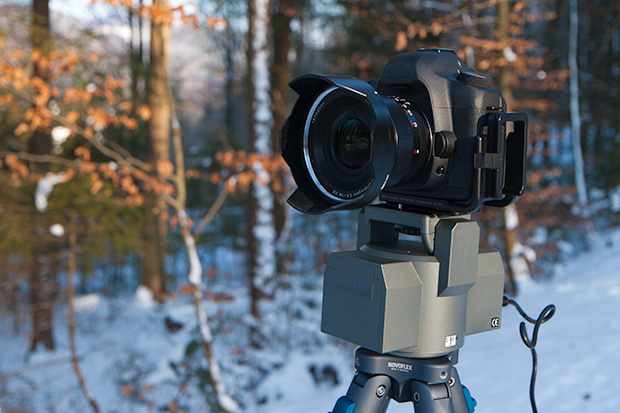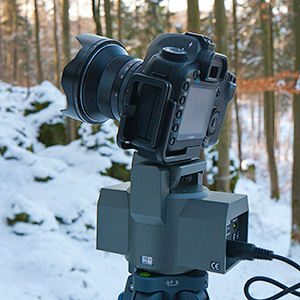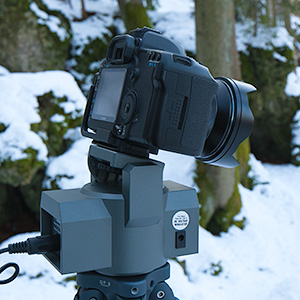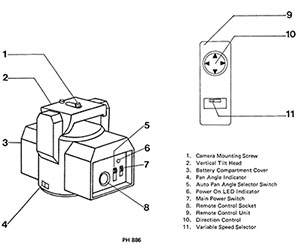equipment reviews
maxwell electronic power panner mp-101
Because such images are so difficult to obtain and because they give the viewer the feeling of being with the animal in immediate proximity, photos of wildlife taken from close distance with wide-angle, standard or short telephoto lenses are much more impressive than the usual shots with a super telephoto lens that most nature photographers do. The usually preferred way to such photos is to hide and wait till the animal comes close enough for the reach of the lens. I have always admired such images created by other photographers but myself haven't had enough opportunities to practice this kind of wildlife photography so far.
Since I usually photograph nature while I am traveling, I have neither time nor equipment for approaching wildlife for a close-up shot. If no hide is available at the location where I am going, I don't bring my own because I never stay there for longer than a couple of hours. This is not because I don't like sitting in a hide or don't want to stalk an animal. It is the programme of the trip, its itinerary, or other circumstances, such as local rules, organization, etc. that just don't allow this. If you have already travelled to photograph nature in a country like Tanzania or Costa Rica for as short as just two or three weeks, you would know what I mean. In quite many situations it is impossible to get close to the animal for an objective reason — for instance, if it is dangerous or too shy, or is staying in a place that is not accessible for a human, e.g. too high on a tree or a rock. Another problem with traditional "seek-and-hide" close-up photography is that typically only large animals can be photographed this way: A small or medium sized animal, even if it comes close to your hide, will always be still too far for a wide-angle lens. Since for wide-angle shots of small animals such as small birds, rodents or reptiles, a camera should be less than in half a meter from the subject, a photographer trying to approach it with a camera will almost certainly scare the animal off before he makes a shot.
In industry, military, space, and everywhere else, if a task is too dangerous or impossible to do for a human, they would send a robot. In wildlife photography, tasks that I outlined above would certainly be suitable for a robot with a DSLR camera but unfortunately none is currently available on the market. A partial solution can be a remotely controlled DSLR camera mounted on a tripod head that is moved by an electric motor. The motor should allow adjustments of camera's view field if the subject moves or lives it completely. The frame composition should be controlled via a small video camera that is sending a picture from the viewfinder to the receiver that the photographer is holding in his hand. This setup is what I am experimenting with, and the tripod head that I am going to review here is its part.
Surprisingly, there are quite few such devices for photo cameras on the market. The need for a motorized tripod head for photo cameras in some situations is so obvious that I can't believe that the first such products appeared only recently. It looks like they first became an issue of interest for a mass consumer after the popularity of consumer video cameras had grown and HD video capable photo cameras appeared. However, for professional video and cine cameras motorized supports have been known already many years before. For example, such professional camera mounting systems are being manufactured by Varizoom and used in film and TV studios. For use in nature photography such equipment is too bulky and heavy, and, with the price tag of several thousands of dollars — too expensive for most amateurs who would need it only occasionally. In 2010, Gitzo presented GH5130RC Athena — the first professional quality motor-driven head for DSLR cameras on the market. At the time of writing, this product wasn't yet available for purchase, and no definite retail price was yet announced. However, some dealers were already offering pre-orders of it for about 10,000$. This head looks like the technically most advanced and best quality motorized head for photo cameras so far. Unfortunately, its price would exceed the budget of most photographers. If a wildlife photographer would have this amount of money, he would most likely prefer to spend it for a 800 mm lens rather than for a tripod head.
When I was researching the market for alternatives, I came across a very inexpensive head that was offered by a UK online shop. After that I found an offer in Germany where I got my copy of this device.

Maxwell Electronic Power Panner in the field — with Canon EF 5D Mark II (ca. 750 g) and Carl Zeiss Distagon T* 3.5/18 ZE (ca. 500 g).
According to the information I could find so far, this panning head had been developed by a German but was patented by a company called Maxwell Electronics Ltd. (see here or here.). There are quite many companies with such name, and most that you find, if you search the Internet, have something to do with electronics and electrics. Therefore, I haven't found out yet which one is the manufacturer. The letters "HK" in the address of the patent assignee indicate that this company's headquarter is in Hong Kong.
At the time I purchased mine, the very same motorized head was offered by US shops such as B&H Photo Video and Adorama under the name Bescor MP-101 Motorized Pan Head, and was presented at the website of the US company Bescor (www.bescor.com). In the UK, the company Hague Camera Supports (www.b-hague.co.uk) was selling the same product under the name Pan & Tilt Power Head and in modifications labeled "PH", "MPH" and "UPH", as if it were their own — without mentioning any other manufacturer. Items sold by Bescor were labeled as "Made in China". My copy of it that I purchased in Germany lacks any indication of its country of origin. It has a label Maxwell and is called Electronic Power Panner. The model is the same — MP-101.

Maxwell Electronic Power Panner, aka Bescor MP-101 Motorized Pan Head, aka Hague Pan & Tilt Power Head. On this picture, it has a very solid look — as if its enclosure is bullet proof. Unfortunately, it is just grey plastic.
features
There are at least 3 modifications of this device — each with slightly different technical features — but the MP-101 looks like the base of all of them. The most significant difference between those variants is the angle of panning. The basic type — MP-101 — turns left and right at 90°, i.e. at 180° all together. There is one modification that can turn at 360° and another one — 340°. I preferred the one with 180° panning because I don't imagine a situation when I would need the camera to completely turn away from the scenery it was initially set up to capture. The speed that this head turns with is quite low: at least 15 seconds are necessary for turning at 180 degrees. Thus, it won't be possible to follow a fast moving subject, i.e. I don't expect to quickly re-target the camera by turning it at 340 or 360 degrees if the subject moves behind it. The 340-degree model has an infrared remote control which is useless outdoors, however, because it operates only at a very short distance and will stop working in the sun.
All three heads share the following features:
- Horizontal panning, as mentioned above — at 180°, or 340°, or 360°, respectively.
- Tilt at about 30°, i.e. ca. 15° down and ca. 15° up.
- Panning at two speeds — 3°/s and 12°/s (continuously adjustable)
- Tilt at two speeds — 1°/s and 3°/s (continuously adjustable)
- 2.7 kg maximum load capacity.
- Wired remote control for tilt direction — up and down — and for panning speed and direction — left and right.
- 1/4" camera mount screw.
- Operating temperature: +3° - +46°C.
- Power source: 4 x AA cells, or 6 to 8 VDC external power supply.
- Weight: about 770 g (without batteries).
- Dimensions: 145 x 115 x 103mm.
At pictures found in the Internet, the MP-101 looks like a tank — as if its enclosure is made of metal and painted grey. Unfortunately, the material is plastic, but a quite hard kind of it, what is grey is not a finish but the plastic itself. The whole construction may be a bit lighter due to that, but I am a little disappointed because I had preferred a metal housing here. The enclosure of MP-101 has a rectangle shape and looks like a case.
The main parts of this head are showed by the drawing that you see at the right — click on it to enlarge. At the front side, behind a plastic lid, there is a compartment for 4 AA batteries. At the rear, there is a panel with two switches and a socket for remote control. The remote control is connected to it with a large (old-fashioned) DIN (5/180°) plug that attaches quite firmly. (See the picture below. To enlarge, click on it.)
The MP-101 head is shipped with a remote control unit that has a 1 m long connection cable. Of course, it is too short for wildlife photography. The dealers who sell this device offer 5 and 20 m extension cables. I got a 20 m one.
operation
The head can operate in two panning modes — manually controlled and automatic. In automatic mode, it turns left and right by itself — when you aren't pushing the button on the remote control. In this mode, however, the remote control cable has to remain plugged into the socket. When the switch with the labels "Off", "M" and "A" is in position "Off", the power is turned off. With this switch in position "M", the head is controlled manually. "A" activates automatic panning.
With the second switch (Auto Pan Selector Switch), limits for panning can be set. It works only in automatic mode, i.e. when the power switch is set to "A". It has four positions: "0", "30", "60" and "90". When it is set to "0", the had stands still at 0, i.e. in the middle. If it was turned to other position before, it returns to this point and stops. When the switch is set to "30", "60" and "90" the head will be turning automatically left and right at this angle, i.e. at 30, 60 or 90 degrees left and right from the middle. The whole panning angle will then be 60, 120 and 180 degrees respectively. The head stops moving after the power switch was brought in positions "M" (manual mode) or "Off", or this switch was set to "0". Probably, it is something useful for videography or for a security camera, but I am not sure that ever I will make use of this feature in my photographic work.
With only 15° in each direction, the tilt angle is quite little (see pictures below) but should be enough in most situations.
 |
 |
 |
These pictures demonstrate the maximum tilt of Maxwell Electric Power Panner.
Other than, for instance, the new Gitzo Athena, the MP-101 has only two rotation axes. It lacks the ability for lateral tilt. This will result in tilted horizon on your photos if the base of the head won't be rotating on an absolutely horizontal surface. When used for landscape photos and particularly for panoramas, the MP-101 has to be put on a leveling base or on top of a ball head.
The motor is very quiet. When it is outdoors, you can hardly hear its sound. Of course, some animals have better sense of hearing than humans, but the noise is so low that it wouldn't probably scare even them.
The weight that the MP-101 head can support is not great: A professional camera body and a mid-sized lens should be just the maximum that you put on it. Anyway, I am not going to load this head up to the limits, i.e. up to 2.7 kg. This shouldn't be a problem because my camera and a wide-angle lens that I am going to use with it bring less than 2 kg of combined weight.
The quite moderate operating temperature range may be a problem in the field. With such a cheap device that was made in China, I think, those limits should be taken seriously, i.e. it would be wise not to exceed them too much. However, I already have been testing my MP-101 outdoors at -4 for about an hour, and didn't notice any malfunction. On that day I was carrying it with my other equipment for at least 3 hours while the temperature in the backpack was well below +3 degrees that the manufacturer states as the lowest limit, and also with no bad consequences.
conclusion
The biggest question is if this device meets my expectations. Except the somewhat disappointing plastic enclosure, the MP-101 that I have now in my hands is just about what I expected when I ordered it. Certainly, it has too many weaknesses, to be considered as perfect. Since this device was most likely made in China, and I don't know how serious the manufacturer is, my biggest concern is the durability of it. If it breaks soon, it will be a signal for me not to buy another one again. I will then look for a more expensive but better-quality motorized tripod head. If this one would work for at least a couple of years and withstand the tough conditions of wildlife photography, it will prove to be good enough for its price. I will say then that it is a bargain compared to the very pricy alternatives.
Certainly, I am going to update this article with further impressions and to report my experience as soon as I have used the Electric Power Panner in the field. Now I am only able to sum up the obvious cons and pros of it. Here they are:
pros:
- The MP-101 is powered by standard AA batteries: Some professional motorized camera supports need much more energy, and some have to be connected to mains or used with high capacity portable power sources. Therefore, their use in the field may be problematic.
- This device is very quiet.
- It is inexpensive.
- The MP-101 is very compact compared with other such devices and even with some mechanic tripod heads.
- It is relatively lightweight. It weighs about as much as any large tripod head.
cons:
- No radio control: This is what I am missing the most. The MP-101 can be controlled only via cable. For someone with good knowledge of electronics or for a company, it could be technically possible to create a radio control for it. But I can't do it myself.
- Load capacity: 2.7 kg that this head can officially support is not much, and even to reach this limit, looks dangerous.
- Build quality: I mean first of all the plastic enclosure, that I mentioned a couple of times already.
- No side tilt: It is a minor flow, of course, but a possibility to level the camera horizontally were nice to have.
- No weather sealing: The MP-101 head per se isn't protected from moisture or dust, and the photographer should care for it.
- Too narrow operating temperature range: For nature photography, +3°C is too high lower limit. The upper limit of +46°C is too low if the head should be used in the sun.
If it works, I think this head may do a good job in wildlife photography — for adjusting the field of view of a remote camera — as well as in landscape photography — for single raw panoramas.

